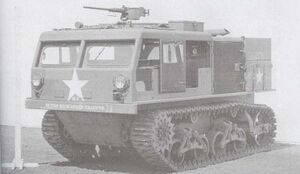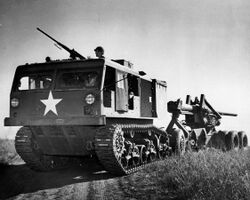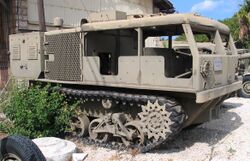Engineering:M4 Tractor
| M4 Tractor, High Speed, 18 tons | |
|---|---|
 M4 high speed tractor with 90-mm ammo box | |
| Type | Artillery tractor |
| Place of origin | United States |
| Service history | |
| In service | 1943–1960 |
| Used by | US Army Belgian Army |
| Wars | World War II |
| Production history | |
| Designed | 1942 |
| Manufacturer | Allis-Chalmers |
| Produced | March 1943-August 1945 |
| No. built | 5,811 |
| Variants | 90 mm antiaircraft gun tractor 155 mm gun or 8-inch howitzer tractor |
| Specifications | |
| Mass | 31,400 lb (14.2 t) |
| Length | 210 in (5.33 m) |
| Width | 97 in (2.46 m) |
| Height | 99 in (2.51 m) |
| Crew | 1 + 11 |
Main armament | M2 Browning machine gun |
| Engine | Waukesha 145GZ OHV I6 gasoline engine 210 hp (157 kW) |
| Power/weight | 14.70 hp/t |
| Suspension | Horizontal volute spring |
Operational range | 100 mi (160 km) |
| Speed | 35 mph (56 km/h) |
The M4 High-Speed Tractor for World War II was an artillery tractor used by the US Army from 1943.[1]
Design and development
The M4 High Speed Tractor used M4 Sherman tracks, roadwheels and drive sprocket. However, the suspension was of the HVSS type, first introduced on a Light Tank T6 project in 1938.
One variant was designed to tow the 90 mm anti-aircraft gun, and another was for the 155 mm gun or 8-inch howitzer.[1] The rear compartment carried the gun crew and other equipment and some later variants included a crane to assist with heavier projectiles.[1] Two types of ammunition boxes were used on all models: a 90 mm box with side "tailgates" to access 90 mm shells pigeon-holed in the sides, and a combination box for 155 mm or 8-inch ammunition.
History
The M4 was built by tractors manufacturer Allis-Chalmers of West Allis, Wisconsin, starting in 1943 and was in U.S. military service until approximately 1960.[1] After WWII, under the US Mutual Defense Assistance Program, M4s was supplied to Greece, the Netherlands, Japan, Brazil, Yugoslavia and Pakistan and several other states friendly to the USA.[1] In the Indo-Pakistani War of 1965 the Pakistani Army used M4 Tractors to haul their M115 Howitzers to the battlefield of Chamb and then to the front at Lahore during the fighting with Indian troops.[citation needed]
Variants
- M4: base model. 2,464 were configured to tow the 90 mm antiaircraft gun, while 3,088 were configured to tow the 155 mm gun or 8-inch howitzer
- M4C: The "C" designation indicates spare ammunition racks configured in the crew compartment.
- M4A1: The "A1" modification designates the wider suspension used for the "duck bill" tracks mirroring the E9 modification on Sherman tanks. 259 were built in 1945, and were used post-war as a prime mover for the M23 ammunition trailer in M40 Gun Motor Carriage sections.
Civilian use
After the war many types of these tractors were stripped of their military components and used for log skidders and power line construction. Many were used as carriers for rock drills, used in logging road construction in British Columbia. The first prototype was designed in the early 1960s by G.M. Philpott Ltd. of Vancouver, BC, and Scott-Douglas Industries, who supplied the M4 Carrier. It was used by MacMillan, Bloedel, and Powell River Company at their Juskatla, BC logging operation. Many improvements were made and when Finning Tractor later bought G.M. Philpott, the machine became the Finning Tank Drill. At least 500 were built, many of which are still in service. The original Finning Tank Drill was replaced by the M32F and M40F Tank Drills, which used larger Sherman tank carriers.[citation needed] At Amsterdam Airport Schiphol in the Netherlands, at least two refurbished M4s were used by the airport fire brigade in the 1960s and '70s.[2]
Surviving vehicles
- Robert Gill Collection militarymuseum.at, Vienna, Austria
- Armed Forces Military Museum, Largo, Florida.[citation needed]2 pieces in the Robert Gill Collection militarymuseum.at, Vienna Austria
- Fort Sill Museum, Oklahoma.[citation needed]
- Gunfire Museum, Brasschaat, Belgium.[citation needed]
- National Military Museum in Soesterberg, The Netherlands.[citation needed]
- Batey ha-Osef Museum, Tel Aviv, Israel.[citation needed]
- Heartland Museum of Military Vehicles in Lexington, Nebraska.[citation needed]
- Marshall Museum in Lexington, Virginia.[citation needed]
- private collection in Colorado.[citation needed]
- private collection in Gettysburg, Pennsylvania.[citation needed]
- private collection in Grand Prairie, Texas.[citation needed]
- private collection in Leicestershire, UK.[citation needed]
- Royal Dutch Army historical collection Maaldrift, The Netherlands.[citation needed]
- private collection in Molsheim, France .[citation needed]
- private collection in O'Neill, Nebraska.[citation needed]
- private collection in Orlando, Florida.[citation needed]
- private collection in Troyes, France.[citation needed]
- private collection in The National Military Vehicle Museum, South Australia
- private collection in Sydney Australia as of April 2022
See also
- List of U.S. military vehicles by supply catalog designation (G150)
- List of U.S. military vehicles by model number
- M5 Tractor
- M6 Tractor
- Raupenschlepper, Ost
References
- Notes
- ↑ 1.0 1.1 1.2 1.3 1.4 Trewhitt, Philip (1999). Armoured Fighting Vehicles. p 307: Dempsey-Parr. ISBN 1-84084-328-4.
- ↑ "Modelbouw, jan korte, brandweer amsterdam, brandweer schiphol, beba, behoud erfgoed brandweer amster". http://www.modelbouwjankorte.nl/.
- Bibliography
- "US Army M-4 High Speed Tractor". olive-drab.com. http://www.olive-drab.com/idphoto/id_photos_m4_hst.php.
- "TM-9-2800-1947 Military Vehicles". US Dept. of the Army. 27 October 1947. https://www.scribd.com/doc/188375301/TM-9-2800-1947.
- TM 9-785 18-Ton High Speed Tractors M4, M4A1, M4C, M4A1C
- SNL G150
- the Field Artillery Journal, September 1945 references the M4A1 as an ammunition hauller for M40 Gun sections.
- Doyle, David (2003). Standard catalog of U.S. Military Vehicles. Kraus Publications. pp. 402–403. ISBN 0-87349-508-X.
External links
 |




